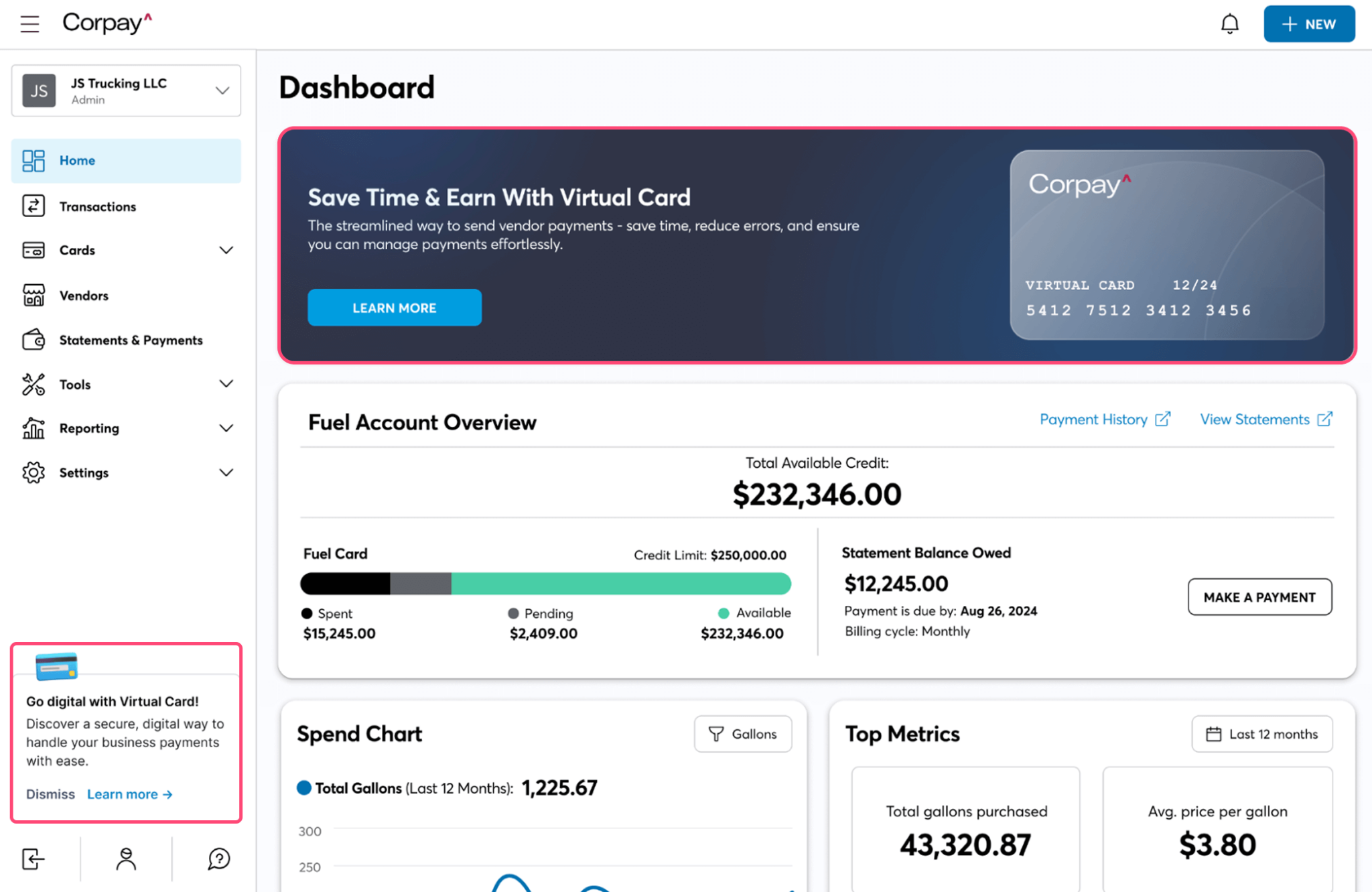
Corpay is a Corporate Payments Company- a global S&P 500 provider of commercial cards, AP automation solutions, and cross-border payments to businesses worldwide.

Corpay needed to increase adoption of its virtual card offering—a key revenue driver—but was slowed down by limited developer resources.

Using Pendo Embedded Guides in the Corpay One platform, Corpay created persistent, contextual dashboard experiences that drove feature adoption without requiring engineering support

Corpay achieved a 12.7% conversion rate (up from 3-5%), reduced time-to-market for new in-app experiences by 99%, and transformed their product into a marketing engine.
For businesses in the increasingly competitive fintech space, driving adoption of high-value features is essential to revenue growth. But what happens when promoting those features becomes a bottleneck?
That was the challenge facing Corpay, a leading provider of payment and expense solutions for field-based businesses. The company needed to increase engagement with its virtual card offering—a key revenue driver—but was hampered by slow development cycles.
“Before Pendo Embedded Guides, we relied on our engineering team to create in-app experiences that promoted new features,” said Joshua Miller, senior product owner at Corpay. “A single test could take up to four weeks to design, build, and deploy.”
This lengthy process severely limited what Miller’s team could accomplish. “It was just too slow. We’d have to request engineering support, go through a dev cycle, test it, and maybe rebuild if it didn’t perform. It limited what we could try.”
While the team had access to Pendo Overlay Guides, adoption rates for key features remained stubbornly low—between 3% and 5%.
Everything changed when Miller started using Pendo Embedded Guides. Unlike traditional overlay guides, these can be seamlessly integrated into the product interface—creating persistent, contextual content that feels native to the experience.
In 30 minutes, I can build something in Pendo that used to take engineering four weeks to create. That changes everything.
Joshua Miller, Sr. Product Owner, Corpay
Miller began building and adding “navigation cards”—bold, benefit-focused tiles that promoted feature adoption the moment a user logged in—directly into Corpay’s dashboard. These included links to help center articles, polls, click-through guides, and even legal disclaimers to support rebate offers, all without writing a single line of code.

“Embedded guides are a game-changer. I can test and iterate on more ideas, and we’re seeing way better business outcomes. Our overlays used to feel like interruptions—these feel like part of the product.”
The impact was immediate and impressive. One of Corpay’s new embedded guides achieved a 12.7% conversion rate—a dramatic improvement over the previous 3-5% they’d seen with overlays.
Most impressively, the team measured a 4x increase in conversions on the same page where previous approaches had struggled.
Miller attributes this success to three core factors:
Corpay’s use of embedded guides goes beyond one-off feature promotion. “We’ve built out entire flows,” Miller explained. “We’re using embedded guides for onboarding, upsell prompts, rebates—everywhere.”
The team also has future plans to use embedded guides to mimic carousel behavior and simulate in-app demo flows, building mock feature walkthroughs entirely in Pendo.
“I used to hack things together that sort of worked. Now, embedded guides just do what I need—and they do it really well.”
Miller’s team is now expanding the use of embedded guides across multiple business lines and rethinking how onboarding flows should work. They’re moving away from hardcoded components in favor of flexible, modular guides entirely built in Pendo.
Corpay is also planning to build in-app demo flows using only embedded and overlay guides, eliminating the need for external tools or dev-built environments.
“We’re turning our product into a marketing engine—and embedded guides are the foundation,” Miller explained.